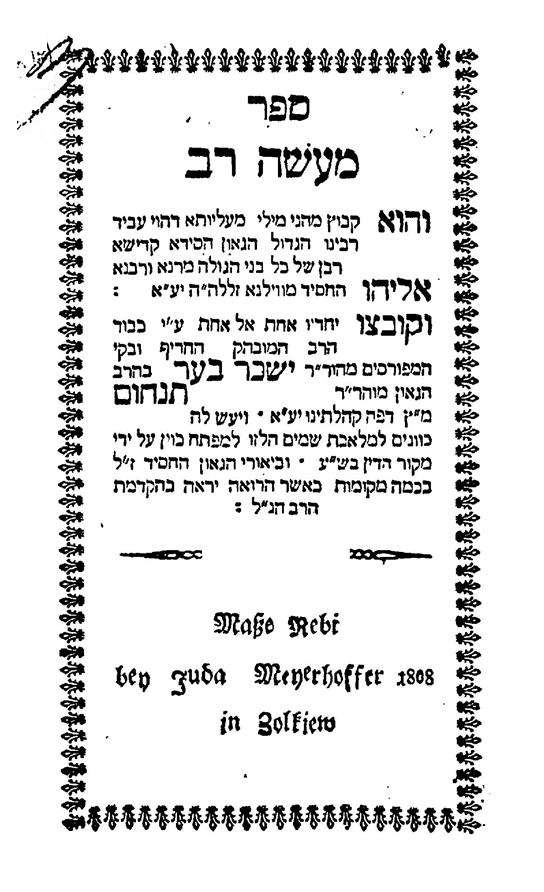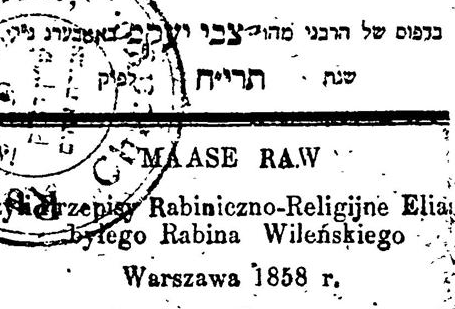
It's title in Blackletter (=the German alphabet of the time) reads Masse Rebi (and not the expected Raw or Rab). It's possible that there's some sort of Polish explanation for this (it was printed in Zolkiew, Galicia) but I put forth my conjecture that whomever it was that set the type (or wrote it or dictated it for setting) pronouncing the Hebrew רבי (rabbi) instead of רב (also rabbi), and doing it in the traditional Ashkenaz way as Rebbe.[1]
Compare with the Warsaw 1858 edition:

[1]Recognizing of course that there are many subtle variations that I can't reproduce with mere letters, and that in 1808 surely no one said it American-style like Reh-bee.





No excuse from Polish there.
ReplyDeleteAn added wrinkle - the Gaon had no semicha so technically he wasn't a Rav.
ReplyDeleteSemicha doesn't really exist. I'm not going to say it was invented by American congregations in the 1940s, but that's kind of my opinion about it.
ReplyDeleteA much bigger problem is that מעשה רב, as such, didn't exist in 1808.
ReplyDeleteIt is true that it is based on a רשימה of the Gaon's minhagim from the 1790s, but that wasn't by Issachar Baer (who was a teenager at the time), but by Rav Saadia of Vilna, a student of the Gaon.
Nobody thought of publishing the רשימה until 1817, when Issachar Baer collected this and other רשימות of the Gaon's minhagim, and got lukewarm haskamoth from R' Hayyim of Volozhin and R' Abraham Danziger (the author of חיי אדם). Why lukewarm? Because the list isn't so reliable -- Rav Saadia was not one of the most stellar student of the Gaon. (As explained by R' Dr. Elli Stern.)
Anyway, for whatever reason, Issachar Baer did not end up publishing מעשה רב until 1832. This edition (Vilna-Horodna) is the first printing.
I noticed the title page with "1808" on HebrewBooks a few months ago -- the one which you display here. The date "1808" seems to be an intentional attempt to mislead buyers. This is a common phenomenon in 18th (and maybe also 19th) century printing -- write a phony date or place of publication on the title page, to increase the prestige of the book.
Something fishy is going on here.
Thanks for that info. On the one hand, I wanted to be sure this was the first edition, so I looked it up in Benjacob and according to him it was the second and later. I checked Fuerst and according to him it was from 1808 as indicated on the title page, so I just went with him.
ReplyDeleteThat said, I was surprised that there is neither a censor's note or a haskama in this edition. I also thought it was odd that it *only* had the non-Jewish date. Like you said, something is fishy. But it makes sense that this is the first printing anyway, since the other one has the appended note of R Chaim in the beginning. Thanks for clearing it up.
I think that changing the place of publication often had to with reasons other than prestige. For example, many Chasidic books had false places of publication and dates after their printing was outlawed.
Hi,
ReplyDeleteMar Gavriel's mention of Dr. Eli Stern's work sounds very interesting; is it available anywhere online?
It's probably in his dissertation "Elijah of Vilna and the making of modern rabbinic Judaism." If you send me an email I can send it to you.
ReplyDeleteThis Zolkiew printing was NOT the first printing. The first printing was Vilna-Horodna, in 1832. The Zolkiew printing was in 1840.
ReplyDeleteRebbe and Rebbi sound different in Polish.
ReplyDeleteRebbi isn't Admor. Rebbe is.
Also, Rav Yissachar Ber was a dayan in Vilna and one of the leaders of the Gaons Kloiz. He met the Gaon briefly as a child but was very close to his leading talmidim R' Saadya and R'Mendel Shklover.
The Gaon changed many minhagim during his lifetime and we can assume that the tradition from later talmidim (especially R' Mendel and R'Yisrael) better represents Gaon's opinions.
It is not surprising that R' Chaim Volozhiner (who in the latter years visited the Gaon only occasionally) didn't recognize some minhagim.
Mar Gavriel:
ReplyDelete"The Zolkiew printing was in 1840"
institute for hebrew bibliography catalogues "lemberg?, after 1833" because it is identical to the lemberg, 1833 edition. this edition is very different than the editio princeps and institute conjectures that the lemberg edition was actually the one that was originally for printing
i meant to write that the text of the lemberg edition was the one originally prepared for printing even before the 1832 edition.
ReplyDelete"I'm not going to say it was invented by American congregations in the 1940s, but that's kind of my opinion about it."
ReplyDeletePretty good example of apophasis, I think that's called.
That should be whoever, not whomever (in the third line under the title page).
ReplyDelete